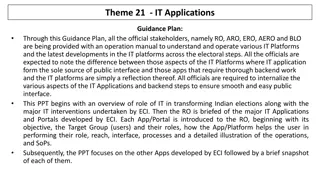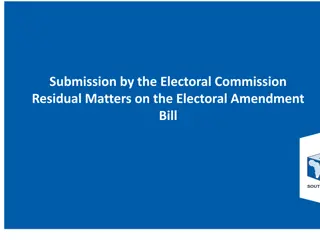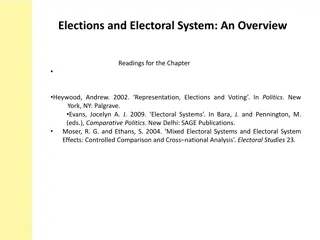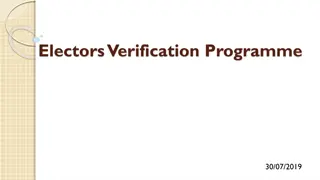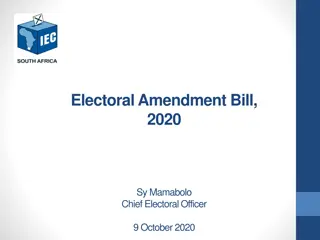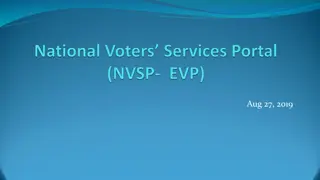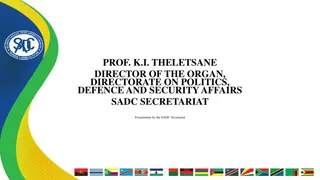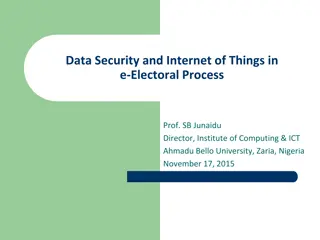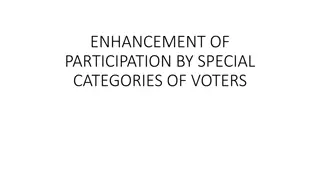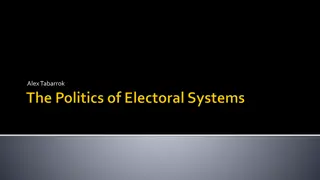Electoral Systems and Integrity
Elections and electoral systems play a crucial role in democratic societies. Electoral integrity is essential for ensuring fair and transparent elections. Learn about the classification of democracies based on electoral systems, the importance of electoral integrity, and the impact of violations on the electoral process.
Download Presentation

Please find below an Image/Link to download the presentation.
The content on the website is provided AS IS for your information and personal use only. It may not be sold, licensed, or shared on other websites without obtaining consent from the author.If you encounter any issues during the download, it is possible that the publisher has removed the file from their server.
You are allowed to download the files provided on this website for personal or commercial use, subject to the condition that they are used lawfully. All files are the property of their respective owners.
The content on the website is provided AS IS for your information and personal use only. It may not be sold, licensed, or shared on other websites without obtaining consent from the author.
E N D
Presentation Transcript
Investigating the Significance of Wild Aloe (Aloe ferox) Harvesting in the Livelihoods of the Rural Communities of the Eastern Cape, South Africa Mosweu S, Zhou L & Agdhassi F University of Fort Hare
Structure Introduction Methods Results and Discussion Conclusion and Recommendations Future Research Activities
Introduction The practice of Aloe ferox harvesting for various purposes started more than 300 years ago in South Africa (Newton and Vaughan,1996). The communal areas of the Cape region are considered to have developed into hot spots for Aloe ferox harvesting in over the years. In the recent years, limited livelihood options to rural communities and increased opportunities for commercial exploitation of Aloe ferox rendered its harvesting to be one of the alternative livelihood activities for the poor rural communities inhabiting communal areas of the Cape region (Shackleton et al, 2009). However, there are few studies focusing on the significance of Aloe ferox harvesting in the livelihoods of the rural poor communities.
Introduction Single stemmed, perennial shrub, height of 2-3 metres, succulent leaves. Stems are characteristically clothed in a skirt of dry leaves. Boat-like shaped leaves which curve upwards and bordered by sharp reddish spines. Figure1. Aloe ferox plant
Introduction The aim of this study was to investigate the significance of Aloe ferox harvesting in the livelihoods of the rural poor communities of three villages (Khayamnandi, Pumulani and Jani) in the Eastern Cape Province of South Africa.
Methods Questionnaires were used to obtain data related to the perceptions of the communities about the significance of Aloe ferox harvesting in their livelihoods. Questionnaires were administered through individual interviews . A total of 38 individual (32 females & 6 males) were interviewed. A focused group discussion (15 individuals) was conducted. Field observations were undertaken.
Results and Discussion 1-2L of exudates 20L = R240.00 approximately 22 USD Figure 3. Process of Aloe tapping
Results and Discussion All respondents found that Aloe tapping was already being practiced when they grew up. They learnt how to do Aloe tapping through observing elders who were already acquainted with the activity. The respondents were compelled to join Aloe harvesting group by lack of options for income generation. They were not aware of policy 8 issues that affect their involvement Grants Aloe 25 in this activity. Figure 4. Income and livelihood dependency
Results and Discussion Harvesting was conducted any day except during rainy and windy days as these conditions negate productivity of the Aloe exudates. 7 respondents indicated that 2 members of their families were involved, while 1 mentioned that 3 family members were involved. Since the Aloe harvesting is conducted some distance away from the settlements, the harvesters usually go out in groups for security purposes. All harvesters did not have effective protective equipment, although some used conventional gloves, boots and coats.
Results and Discussion 9 Medicinal use & income generation Income generation only 29 Figure 5. Aloe uses Respondents indicated that some risks associated with Aloe harvesting include snake bites and injuries from the spines. They also alluded to some illnesses that they believed were caused by inhaling gaseous products from Aloe exudates. This was however difficult to ascertain.
Results and Discussion Suggestions from the respondents Government should provide personal protective equipment, set prices, provide needed machinery, train Aloe harvesters, provide funds to start cooperatives/ groups.
Conclusion and Recommendations This research established that Aloe ferox harvesting is a potential poverty alleviation communal activity which can be implemented in the rural areas of the Eastern Cape. It is however not immune to challenges: Lack of organization and coordination among the harvesters. Lack of knowledge regarding the policies and regulations guiding the activity. Lack of appropriate equipment. Lack of monitoring and regulation of Aloe harvesting rates. The communities may be assisted by governmental organization or non-governmental organizations to form community based natural resources management trust.
Future Research Activities Determine ways of assisting the communities to establish a community based natural resource management trust. Liaise with governmental and non-governmental organizations on issues of empowering the communities on Aloe harvesting related matters. Continue this research by incorporating issues concerning sustainability
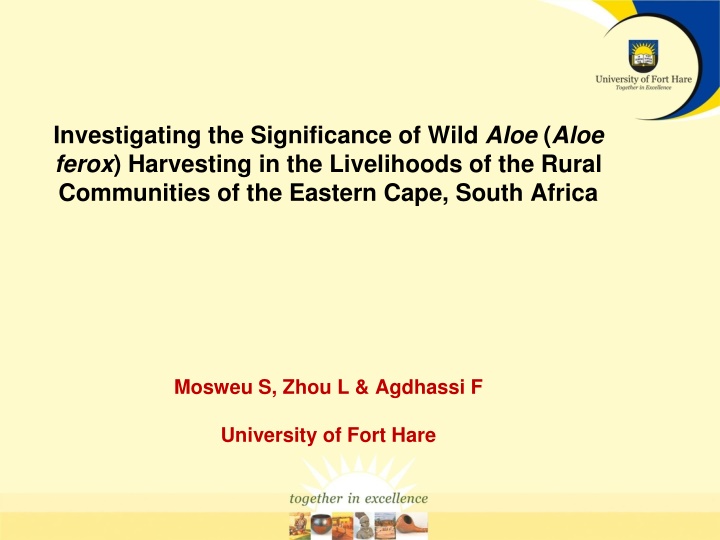

![RE: ELECTORAL MATTERS AMENDMENT BILL [ B42-2023]](/thumb/18837/re-electoral-matters-amendment-bill-b42-2023.jpg)


